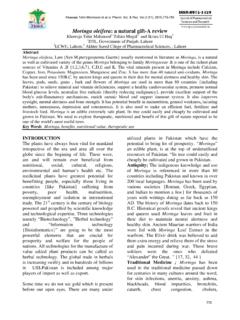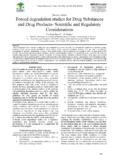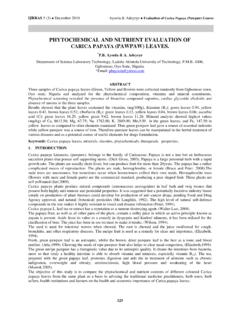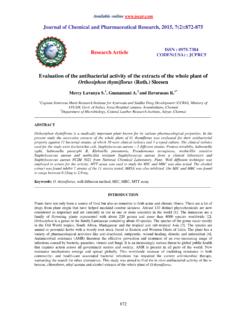Transcription of Preliminary Phyto-profile and Pharmacological …
1 Preliminary Phyto-profile and Pharmacological evaluation of some Extracts of Cenchrus grass against Selected Pathogens. Dr. Premlata Singariya*1, Dr. Krishan Kumar Mourya2 and Dr. Padma Kumar3 1. Dr. Kothari Post doctoral fellow, Laboratory of Tissue Culture and Secondary Metabolites, Department of Botany, University of Rajasthan, Jaipur- 302004. 2. Nodal Officer, Animal Husbandry Department, Pahari (Bharatpur) Rajasthan. 3. Professor, Department of Botany, University of Rajasthan, Jaipur-302004 Abstract Aim: The aim of present study is to investigate the antimicrobial activity of Cenchrus ciliaris (CAZRI-358) and Cenchrus setigerus (CAZRI-76) extracts in order to use it as a possible source for new antimicrobial substances against important human pathogens. Methods and Results: Crude extracts of different parts of both species of Cenchrus were evaluated against three medically important bacteria viz.
2 Pseudomonas aeruginosa (Gram-ve), Bacillus Subtilis (Gram +ve), Enterobacter aerogens (Gram-ve) and one fungi Aspergillus flavus. The dried and powdered parts (root, stem, leaf and seed) were successively extracted with petroleum ether (PE), ethyl acetate (EA) and glacial acetic acid (GAA) using soxhlet assembly. The antimicrobial activity assay was done by both disc diffusion and serial dilution methods. The highest yield was found in root extract in different polar solvents. Maximum antibacterial activities were observed by GAA extracts of seed in both species of Cenchrus against Bacillus Subtilis and antifungal activity by root extract of C. ciliaris. Conclusion: Cenchrus grass easily grows in harsh climatic conditions or xeric conditions and requires less care, hence its use as raw material for preparing drugs would definitely be economical. Significance and Impact of Study: The present investigation provides a scientific basis for the use of these plant extracts in home-made remedies and their possible application against micro-organisms.
3 Keywords: Aspergillus flavus, Antibacterial, Cenchrus, glacial acetic acid extract and Pseudomonas aeruginosa. INTRODUCTION The use of plant antimicrobials started [1] in antibiotic era in the 1950s and from then onwards. Plants can produce a large number of secondary metabolites that may exceed a hundred thousand molecules [2]. Over the last three centuries, intensive efforts have been made to discover clinically useful antimicrobial drugs [3, 4, 5]. Plant extracts have been used for a wide variety of purposes for many thousands of years [6]. But on the other hand, the development of resistant strains of pathogenic bacteria to antibiotics currently in use is a problem of continuing concern to public health [7, 8], which have led to the emergence of new bacterial strains that are multi-drug resistant. Nowadays there are various type of antibiotics are available, but number of factors such as low potency, poor solubility, emergence of resistant strains and drug toxicity [9, 10], non-availability and high cost of new generation antibiotics with limited effective span have resulted in increase in morbidity and mortality, Therefore, there is a need to look for substances from other sources with proven antimicrobial activity [11, 12].
4 C4 grasses are gaining attention in various field of research, as they are best suited to the present environmental conditions. C4 grasses are more competitive under the conditions of high temperature, solar radiation and low moisture [13]. C4 grasses are more efficient at gathering Carbon dioxide and utilizing nitrogen from the atmosphere and recycled N in the soil [14, 15]. Cenchrus L. (Poaceae) is highly nutritious grass and considered excellent for pasture in hot, dry areas and is valued for its production of palatable forage and intermittent grazing during droughty periods in the tropics. The grass, fed green, turned into silage, or made into hay is said to increase flow of milk in cattle and impart a sleek and glossy appearance. This grass has excellent soil binding capacity which helps to conserve soil in desert areas [16]. However, Cenchrus is most suitable and highly nutritive grasses for desert environmental conditions; this plant is not well studied from phytochemical & Pharmacological point of view.
5 The present investigation evaluated the antibacterial and antifungal effects of crude extracts of Cenchrus grass (root, stem, leaf, and seeds). Pseudomonas aeruginosa is a common bacterium that can cause disease in animals, including humans. It is found in soil, water, skin flora, and most man-made environments throughout the world. It thrives not only in normal atmospheres but also in hypoxic atmospheres and has colonized in many natural and artificial environments. If such colonization occurs in critical body organs, such as the lungs, the urinary tract, and kidneys, the results can be fatal. Bacillus subtilis bacteria and Aspergillus flavus fungi contaminate food and produce food poisoning. They are used on plants as a fungicide. E. aerogens is a nosocomial and pathogenic bacterium that causes opportunistic infections includes most type of infections.
6 Enterobacter species can also cause various community-acquired infections. Premlata Singariya et al /J. Pharm. Sci. & Res. (8), 2011,1387-13931387 MATERIAL AND METHODS Experimental design: Crude extracts of different parts of Cenchrus ciliaris (CAZRI-358) and Cenchrus setigerus (CAZRI-76) were prepared with a series of non polar to polar solvents by hot extraction method in soxhlet assembly [17], First screened for antimicrobial activity by disc diffusion method [18] against a few medically important bacteria and fungi. The fraction showing best activity was then used for assay of minimum inhibitory concentration (MIC) by tube dilution method [19]. Collection of plant material: Different parts of C. ciliaris (CAZRI-358) and C. setigerus (CAZRI-76) (root, S, leaf, and seed) were collected in the month of August from the Central Arid Zone Research Institute, Jodhpur, Rajasthan.
7 These grass varieties were released from CAZRI, Jodhpur. The collected plant materials were transferred immediately to the laboratory cleaned with deionized water and selected plant parts were separately shade dried for one week. Each shade dried plant parts were powdered with the help of grinder. Fine powder of each sample was stored in clean container to be used for Soxhlet extraction following the method of Subramanian and Nagarjan, (1969) [20] in different polar solvents selected. Extraction procedure: The dried plant material was pulverized into fine powder using a grinder (mixer). About 10 gm of powdered material was extracted in soxhlet extraction apparatus successively [21] with different solvents (250 ml) according to their increasing polarity (petroleum ether < ethyl acetate < glacial acetic acid) for 18 hours at a temperature not exceeding the boiling point of the respective solvent.
8 The obtained extracts were filtered by using Whatman No. 1 filter paper and then concentrated at 400C by using an evaporator. The residual extracts were stored in refrigerator at 40C in small and sterile glass bottles. Percent extractive values were calculated by the following formula and are listed in table-1. Weight of dried extract Percent Extractive = x 100 Weight of dried plant material Drugs and chemicals: The following drugs namely Gentamycin (for bacteria), Ketoconazole (for yeast) and chemicals petroleum ether, ethyl acetate and glacial acetic acid, Nutrient Agar (NA), Sabouraud Dextrose Agar (SDA) were used during the experimental study. Micro-organisms: (a) Bacteria: Pseudomonas aeruginosa (Gram-ve) (MTCC-1934), Bacillus subtilis (Gram +ve) (MTCC-121), Enterobacter aerogens (Gram-ve) (MTCC-111) (b) Fungi: Aspergillus flavus (MTCC-277).
9 Screening of antimicrobial activity: Test pathogenic microorganisms were procured from Microbial Type Culture Collection, IMTECH, Chandigarh, India. Bacterial strains were grown and maintained on Nutrient Agar medium, while yeast was maintained on Sabouraud Dextrose Agar medium. Disc diffusion assay [18] was performed for screening. NA and SDA base plates were seeded with the bacterial and fungal inoculum, respectively inoculum size 1 108 CFU/ml for bacteria and 1 107 cell/ml for yeast [22]. Sterile filters paper discs (Whatman no. 1, 5mm in diameter) were impregnated with 100 l of each of the extract (10 mg/ml) to give a final concentration of 1 mg/disc and left to dry in vaccuo so as to remove residual solvent, which might interfere with the determination. Petri plates were pre-seeded with 15 ml of growth agar medium and ml of inoculum [23, 24].
10 Extract discs were then placed on the seeded agar plates. Each extract was tested in triplicate with gentamycin (10mcg/disc) and ketoconazole (10mcg/disc) as standard for bacteria and fungi, respectively. The plates were kept at 4 C for 1 h for diffusion of extract, thereafter were incubated at 37 C for bacteria (24 h) [25] and 27 C for fungi (48 h). This method was followed by various researchers [26, 27, 28, 29]. The inhibition zones were measured and compared with the standard reference antibiotics [24]. Activity index for each extract was calculated (Table 1). Inhibition Zone of the sample Activity index (AI) = _____ Inhibition Zone of the standard Determination of minimum inhibitory concentration (MIC): The fractions that showed antibacterial potential were further assessed for the minimum inhibitory concentration (MIC), which is the minimal concentration of plant extract, or fraction thereof that inhibits the bacterial growth [19, 30, 31].












